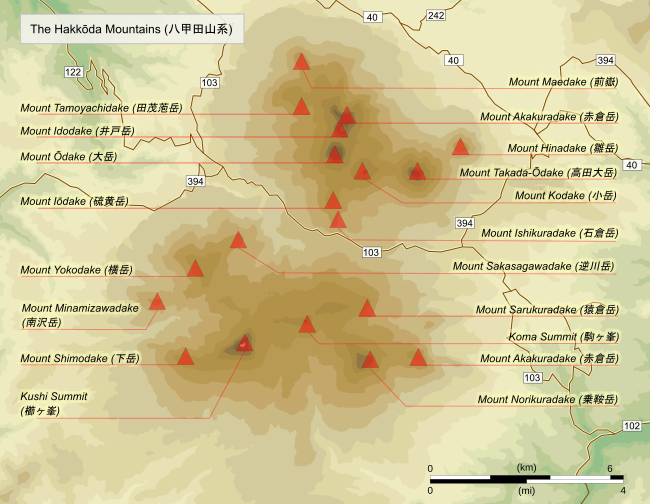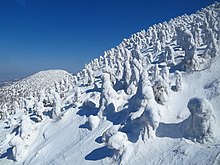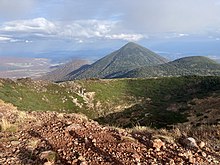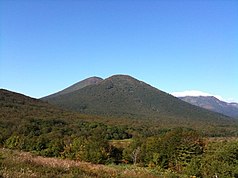Hakkōda Mountains
| Hakkōda Mountains | |
|---|---|
(above) The Hakkōda Mountains viewed from the southeast (below) Thetopographyof the Hakkōda Mountains group | |
| Highest point | |
| Peak | Mount Ōdake |
| Elevation | 1,584 m (5,197 ft) |
| Listing | List of mountains in Japan 100 Famous Japanese Mountains |
| Coordinates | 40°39′32″N140°52′38″E/ 40.65889°N 140.87722°E |
| Naming | |
| Native name | |
| Geography | |
| Country | Japan |
| Prefecture | Aomori Prefecture |
| Region | Tōhoku |
| Parent range | Ōu Mountains |
| Biome | Alpine climate |
| Geology | |
| Orogeny | Island arc |
| Type of rock | Volcanic |
| Last eruption | 1550[1] |
| Climbing | |
| Easiest route | aerial lift/hike viaHakkōda Ropewayand the Hakkōda Ropeway and Hakkoda-odake trails[2] |
TheHakkōda Mountains(Tám giáp điền hệ thống núi,Hakkōda-sankei)are an activevolcanic complexin south-centralAomori Prefecture,Japan, inTowada-Hachimantai National Park.Often calledMount Hakkōda(Tám giáp điền sơn,Hakkōda-san)or simplyHakkōda(Tám giáp điền),the mountains are collectively listed as one of the100 Famous Japanese Mountains.Its highest peak, Mount Ōdake, lies 21.3 kilometers (13.2 mi) southeast of central Aomori and 28 kilometers (17 mi) west of centralTowadaand has an elevation of 1,585 meters (5,200 ft). The Hakkōda Mountains are a partŌu Mountainswhich make up part of theNortheastern Japan Arc,a segment of thePacific Ring of Fire.The volcanic complex consists of fourteenstratovolcanoesandlava domesarranged into twovolcanic groups.The Northern Hakkōda Volcanic Group emerges from the rim of an 8-kilometer-wide (5.0 mi)calderathat dates back to thePleistocene.The Southern Hakkōda Volcanic Group predates the caldera.
The Hakkōda Mountains attract many climbers, skiers, and sightseers. The mountains offer extensive backcountry skiing in the winter and early spring. There is a lift, theHakkōda Ropewayin the northern Hakkōda Mountains used by visitors year-round and several hiking trails cross the mountains. While the trails do not pose any technical climbing challenges, Hakkōda presents dangers such as volcanic gases, harsh winter weather, and avalanches. The most notable incident in mountains' history was theHakkōda Mountains incident,the worst mountaineering accident in modern history.
Geographic setting and description
[edit]AfterMount Iwaki,the Hakkōda Mountains contain thesecond highest peakinAomori Prefecture,Mount Ōdake with an elevation of 1,585 meters (5,200 ft).[3]Mount Ōdake can beclimbedfromSukayu Onsenin about four hours. Heavy snowfall makes the Hakkōda Mountains a prime destination for backcountry and mountainskiers,and there are two mountain huts for overnight trips. The lower slopes of the mountains are forested interspersed withmoorland.Above 1,300 meters (4,300 ft),[4]theAlpine climatezone starts.
The Hakkōda Mountains, along withLake Towadaand theOirase Valley,make up the northern section ofTowada-Hachimantai National Park.[4]The mountains dominate the southern horizon of the city of Aomori. On a clear day they can be seen on a clear day fromHakodateinHokkaido.[5]
Though the Hakkōda Mountains are made up of several mountains they are often collectively called Mount Hakkōda(Tám giáp điền sơn,Hakkōda-san)or simply Hakkōda(Tám giáp điền).[6]The name Hakkōda is a geographic description of the mountains and their appearance. The first part of the name Hakkō(Tám giáp) 'eight armor'from eight of the mountains having peaks that resemble helmets. The second part of the name da(Điền) 'field'refers to the mountains' flat plateaus that are referred to as thần の điền phố(kami no tano) 'field of god'.[7]
List of peaks
[edit]
The following is a list of peaks and their heights:[4][8]
- Northern Group:
- Mount Ōdake(Đại nhạc,Ō-dake)1585 m
- Mount Takada-Ōdake(Cao điền đại nhạc,Takada-Ō-dake)1559 m[9]
- Mount Idodake(Giếng hộ nhạc,Ido-dake)1537 m
- Mount Akakuradake(Xích thương nhạc,Akakura-dake)1548 m
- Mount Kodake(Tiểu nhạc,Ko-dake)1478 m
- Mount Iōdake(Lưu hoàng nhạc,Iō-dake)1360 m
- Mount Tamoyachidake(Điền mậu 萢 nhạc,Tamoyachi-dake)1324 m
- Mount Maedake(Trước nhạc,Mae-dake)1251.7 m
- Mount Hinadake(Non nhạc,Hina-dake)1240.4 m
- Mount Ishikuradake(Thạch thương nhạc,Ishikura-dake)1202 m
- Southern Group:
- Kushi Summit(Lược ヶ phong,Kushi-ga-mine)1516.6 m
- Includes Mount Kamidake(Thượng nhạc,Kami-dake)1516.6 m and Mount Shimodake(Hạ nhạc,Shimo-dake)1342 m
- Mount Norikuradake(Thừa an nhạc,Norikuradake)1449.9 m
- Koma Summit(Câu ヶ phong,Koma-ga-mine)1416.5 m
- Mount Sarukuradake(Vượn thương nhạc,Sarukura-dake)1353.7 m
- Mount Yokodake(Hoành nhạc,Yoko-dake)1339.6 m
- Mount Akakuradake(Xích thương nhạc,Akakura-dake)1297.8 m
- Mount Minamizawadake(Nam trạch nhạc,Minamizawa-dake)1199.0 m
- Mount Sakasagawadake(Nghịch xuyên nhạc,Sakasagawa-dake)1183 m
- Kushi Summit(Lược ヶ phong,Kushi-ga-mine)1516.6 m
Wetlands
[edit]
The Hakkōda Mountains are famous for their high-altitudewetlands:[10]
- Sennin Wetland ( tiên nhân đại )
- Kenashi Wetlands ( mao vô đại )
- Tamo Wetland ( điền mậu 萢)
- Suiren Pond ( hoa súng chiểu )
- Tashiro Plateau Wetland ( điền đại bình ướt nguyên )
Geology
[edit]The Hakkōda Mountains are two clusters ofstratovolcanoesin theNortheastern Japan Arcthat consists oflava flows,debris flows,andpyroclasticejecta and flows arranged into southern and northern groups. The volcanic peaks are made of non-alkalimaficrock; mostlyandesite,dacite,andbasalt.[11]Although both groups of mountains formed in the Pleistocene, the southern group is older than the northern group. The southern group is made from rock that is 700,000 to 1,700,000 years old, while the northern group is made from rock that is 13,000 to 700,000 years old along the southwestern rim of an oldercaldera.[12]
Eight eruptive events have occurred in the Northern Hakkōda Volcanic Group since 4,000 BCE, includingphreaticandvulcanian eruptions.Four eruptive events occurred at the summit of Ōdake, with another possible eruption at Ōdake. The three most recent eruptions occurred at Jigokunuma on the southwestern foot of Ōdake near Sukayu Onsen during the 13th to 17th centuries.[13]
Modern activity and the current threat
[edit]
Two fatal incidents have happened in modern history due tovolcanic gasemitted from the northern group. On 12 July 1997, three soldiers of theJapan Self-Defense Forcesdied after gas accumulated in the valley where they were training.[14]On 20 June 2010, a teenage girl died after being exposed to volcanic gas near Sukayu Onsen.[15]After the2011 Great East Japan earthquake,seismic activity around the volcanic group increased. After a series of earthquakes between February and October 2013, Mount Ōdake saw a degree ofdeformation.[16]
Future eruptions are forecast to come from the peak of Mount Ōdake and Jigokunuma, avolcanic crater lake.Large scale eruptions from Mount Ōdake have the potential to sendlahars(volcanic mudflows) to heavily populated areas of the cities ofAomoriand Towada, to the northwest and east, respectively, of the volcanic complex.[17]Potential lahars would flow to Towada by the Oirase River and its tributaries and to Aomori by the Tsutsumi andKomagome rivers.The junction of the Tsutsumi and Komagome rivers just north ofTsutsui Stationon theAoimori Railway Linewould be the most heavily impacted populated area during a large eruption, with many areas struck by over a meter of debris. An eruption from Mount Ōdake could also produce pyroclastic flows that could travel up to 3.7 kilometers (2.3 mi) and expel lava up to 3.0 kilometers (1.9 mi) from the volcano.[17]Due to volcanic deformation, the summit of Mount Takada-Ōdake shifted 115 meters (377 ft) to the west and increased in elevation by 7 meters (23 ft), shifting its summit from the border of Aomori and Towada to being entirely in the city of Towada.[9]As of May 2020, intensefumaroleactivity was ongoing at Jigokunuma near Sukayu Onsen andNational Routes 103/394.[18]
Human history
[edit]During theJōmon period,human activity rapidly increased in the Hakkōda Mountains after a large-scale,Plinian eruptionof the Lake Towada volcanic caldera. It is hypothesized that the removal of the mountains' beech forest in the eruption made room for the chestnut groves that the Jōmon people in the area relied heavily on.[19]
In 1684, during theEdo period,Sukayu Onsen was founded at a hot spring near Jigokunuma. A hunter tracking a deer he had wounded came upon the deer near a hot spring. The hunter noticed that the deer had apparently been healed of its injuries by the hot spring. The location became known as Shikayu Onsen, literally "the deer's hot spring". As the amount of visitors grew, the onsen became known as Sukayu. The onsen is still a major attraction in the mountains.[20][21]
In 1929,Tohoku Universityestablished the Mount Hakkōda Plant Experimentation Laboratory near Sukayu Onsen.[22]The mountains, along with the Lake Towada area, were set aside under theNational Park Lawas a protected part of Towada National Park in 1936.[23]On 3 August 1953, the national park was expanded, extending its protected status to the Tashiro Plateau Wetland in the caldera of the Northern Group of the Hakkōda Mountains.[24]
After the park was established, the mountains were listed collectively as one of the100 Famous Japanese Mountainscompiled by the mountaineerKyūya Fukadain 1964. This list gained popularity after it gained the attention ofEmperor Naruhito,who would attempt to summit every entry on the list.[25]TheHakkōda Ropewaywas opened in October 1968, providingaerial liftaccess to the top of Mount Tamoyachidake, one of the peaks in the northern Hakkōda Mountains.[26]The Hakkōda Mountains have appeared on apostage stampreleased on 20 July 1951 and, more recently, in a set of stamps released on 30 March 2015.[27][28]Shikō Munakata,an internationally acclaimed localsōsaku-hangaartist, designed a badge for the climbers of Hakkōda in 1954.[29]A 6,409.7-hectare (15,839-acre) portion of the mountains' forests was designated as aBiotic Community Protection Forestin 1989.[30]
Outdoor recreation
[edit]
The Hakkōda Mountains, particularly the area around the Hakkōda Ropeway, Sukayu Onsen, and Mount Ōdake, are a popular destination for skiers and snowboarders from around the world. The mountains offer an extensive area for backcountry winter and early spring recreation, with dry, powdery snow similar to what is seen at resorts in Hokkaido despite being slightly further south.[31][32]Multiple ski resorts serve tourists near the bottom of the aerial lift and within close proximity of Sukayu Onsen.[33]Jōgakura Bridge,spanning the northern and southern groups of the mountains, is a draw for tourists because of the panoramic views it offers of the mountains and their surroundings.[34]
Climbing
[edit]
Climbing to the summit of Mount Ōdake, the highest peak of the Hakkōda Mountains, is not difficult and does not require any technical skill between May and November. To reach the peak climbers start their ascent at Sukayu Onsen or the top of the Hakkōda Ropeway, both of which can be accessed by public buses or private automobiles from National Route 103 and National Route 394. From Sukayu Onsen, it takes about two hours to complete the 694 meters (2,277 ft) ascent to the summit that is accessible by a well-marked pathway.[35]From the top of the Hakkōda Ropeway it takes two hours to ascend to the summit and another two to descend back to the aerial lift.[36]The summit can be reached outside of the mentioned climbing season; however dangers imposed by avalanches and harsh weather make advance training, personalradio beacons,and preparation necessary.[37][38]
Dangers and accidents
[edit]TheHakkōda Mountains incidentoccurred on 23 January 1902, when a group ofImperial Japanese Armysoldiers marched in a blizzard on the Hakkōda Mountains en route to Tashiro Hot Spring located in the Hakkōda Mountains. The 199 deaths during a single ascent make it the world's largestmountaineeringdisasterin themodern historyof mountain climbing.[39]
Two people were killed and 12 were injured after an avalanche struck a hiking party in 2007.[38]A woman who was snowboarding in a backcountry skiing area 400 meters (1,300 ft) away from the Hakkōda Ropeway was killed as a result of another avalanche on 21 February 2021.[40]Depressions in the mountains can trap toxic volcanic gases emitted from vents. These gases have led to the deaths of several people in modern history.[41][15]
Ecology
[edit]
6,409.7 hectares (15,839 acres) of the land area within the Hakkōda Mountains is designated as a Protected Forest. Located primarily to the south of Mount Ōdake, it stretches about half the distance from that peak across the southern Hakkōda Mountains to Lake Towada.[42]It is protected as a Biotic Community Protection Forest due to the variety of forests contained within the relatively compact area of the mountains.[30]
Below the alpine zone that begins around 1,000 meters (3,300 ft), the Hakkōda Mountains are covered withSiebold's beechforests. In the lower alpine zone the mountains contain stands ofMaries' fir,a species offirknown locally as Aomori todomatsu. During the winter these fir trees get blasted with snow, sculpting the precipitation onto the trees resulting in the phenomenon known as "snow monsters".[43]In the higher alpine zone in elevations above 1,400 meters (4,600 ft), the stands of fir thin out and are interspersed with a mixture ofalpine shrubs,primarily made up ofEast Asian alderandJapanese rowan.[44]Hare's-tail cottongrass,evergreen azaleas,andNarthecium asiaticumare flowering plants that can be found in the wetlands of the mountains.[45]
The mountains support a wide variety of animal life. The Tsuta Wild Bird Sanctuary lies within the Southern Group of the Hakkōda Mountains. Its marshes and ponds support populations ofMandarin duck,forest green tree frog,andruddy kingfisher.Other species that can be found in the Hakkōda Mountains are thegolden eagle,theJapanese serow,and theAsian black bear.[46][47]
See also
[edit]- Hakkōda Tunnel
- Jōgakura Bridge
- Mount Hakkoda(1977 film)
- Mt. Hakkoda(2014 film)
- List of volcanoes in Japan
- List of mountains in Japan
References
[edit]- ^"Hakkoda Group".Global Volcanism Program.Smithsonian National Museum of Natural History.Archivedfrom the original on 8 July 2004.Retrieved13 September2008.
- ^"Hakkoda Mountains Area map".Ministry of the Environment. 2016.Archivedfrom the original on 18 February 2020.Retrieved23 June2020.
- ^"Aomori Prefecture".topographic-map.2020.Archivedfrom the original on 31 October 2020.Retrieved28 October2020.
- ^abcHunt, Paul (1988). "27. Hakkōda Mountains".Hiking in Japan: An Adventurer's Guide to the Mountain Trails(First ed.). Tokyo and New York: Kodansha International. pp. 172–175.ISBN0-87011-893-5.
- ^"Tân khinh eo biển"[Tsugaru Strait].Asobihorokerusan(in Japanese).Archivedfrom the original on 22 September 2023.Retrieved22 May2020.
- ^"Thị dân の thanh tám giáp điền sơn という hô び danh をやめませんか"[Citizen's opinion: Let's drop the name Mount Hakkōda].City of Aomori(in Japanese). 16 April 2013.Retrieved25 May2020.[permanent dead link]
- ^"6 tám giáp điền sơn"[6 Mount Hakkōda] (in Japanese). National Diet Library. 2008.Archivedfrom the original on 29 November 2020.Retrieved23 June2020.
- ^"Địa lý viện mà đồ"[GSI Map] (in Japanese). Geospatial Information Authority of Japan. 2024.Archivedfrom the original on 6 March 2020.Retrieved22 January2024.
- ^ab"Bắc tám giáp điền ・ cao điền đại nhạc độ cao 1559メートルに"[North Hakkōda Mount Takada-Ōdake has an altitude of 1559 meters].The Tō-Ō Nippō Press(in Japanese). 15 February 2020. Archived fromthe originalon 28 June 2020.Retrieved25 June2020.
- ^"Tám giáp điền sơn ướt nguyên đàn"[Hakkōda Wetlands] (in Japanese). Archived fromthe originalon 10 February 2013.Retrieved25 May2020.
- ^"HAKKODA Caldera".Quaternary Volcanoes of Japan.National Institute of Advanced Industrial Science and Technology. 2006. Archived fromthe originalon 19 December 2012.Retrieved13 September2008.
- ^"GeomapNavi".Seamless digital geological map of Japan V2.Geological Survey of Japan. 31 January 2014.Archivedfrom the original on 17 August 2020.Retrieved25 May2020.
- ^"NATIONAL CATALOGUE OF THE ACTIVE VOLCANOES IN JAPAN (THE FOURTH EDITION, ENGLISH VERSION) Hakkodasan"(PDF).Japan Meteorological Agency.2013.Archived(PDF)from the original on 23 January 2022.Retrieved19 May2020.
- ^"Tám giáp điền sơn"[Mount Hakkōda] (in Japanese). Japan Meteorological Agency. 2016.Archivedfrom the original on 31 October 2020.Retrieved29 October2020.
- ^ab"Núi lửa ガスか, タケノコ thải り の trung 2 nữ tử tử vong… Thanh sâm"[Volcanic gas leads to the death of girl while collecting bamboo shoots... Aomori].Yomiuri Shimbun(in Japanese). 20 June 2010. Archived fromthe originalon 24 June 2010.Retrieved18 May2020.
- ^"Phun hỏa hoạt động sử"[Eruption history].Japan Meteorological Agency(in Japanese).Archivedfrom the original on 6 April 2020.Retrieved18 May2020.
- ^ab"Đệ 5 hồi tám giáp điền sơn núi lửa phòng tai hiệp nghị sẽ – số trị シミュレーション tính toán kết quả"[5th Hakkoda Volcano Disaster Prevention Council – Numerical simulation calculation result](PDF).Aomori City Government(in Japanese).Retrieved22 May2020.[permanent dead link]
- ^"Kita Hakkoda Volcano Group".Geological Survey of Japan.Archivedfrom the original on 15 January 2021.Retrieved22 May2020.
- ^Tsuji Seiichirō (31 October 2018)."Đệ 5 hồi phun hỏa が văn hóa? Lại び mười hòa điền の thật lớn phun hỏa と yên ống thổ khí văn hóa"[Did the fifth eruption create a culture? Towada's giant eruption and cylindrical pottery culture].Jomon Aomori(in Japanese).Archivedfrom the original on 23 September 2020.Retrieved25 May2020.
- ^"Toan ヶ canh suối nước nóng の lịch sử"[History of Sukayu Onsen] (in Japanese).Archivedfrom the original on 29 May 2020.Retrieved25 May2020.
- ^"A traditional hot spring known as the" 1,000 person bath "nestled in the Hakkoda Mountains".Tohoku Tourism Promotion Organization.2018.Archivedfrom the original on 12 August 2020.Retrieved25 May2020.
- ^"Tám giáp điền sơn phân viên について"[About the Mount Hakkōda branch].Tohoku University.Archivedfrom the original on 10 August 2020.Retrieved25 May2020.
- ^"Mười hòa điền tám cờ bình quốc lập công viên"[Towada-Hachimantai National Park].Kotobank(in Japanese). The Asahi Shimbun Company.Archivedfrom the original on 19 April 2021.Retrieved25 May2020.
- ^"Kế hoạch 変 càng など の kinh vĩ"[History of park changes].Ministry of the Environment(in Japanese).Archivedfrom the original on 22 January 2013.Retrieved25 May2020.
- ^"これが “ロイヤルルート” đức nhân thiên hoàng が bộ いた nói で sơn đăng り! "[This is the "Royal Route" Climb the mountains that Naruhito summited!].Asahi Shimbun(in Japanese). 22 August 2019.Archivedfrom the original on 30 December 2019.Retrieved29 October2020.
- ^"Welcome to Hakkoda Ropeway!".Hakkoda Ropeway.Archivedfrom the original on 26 April 2020.Retrieved25 May2020.
- ^"Mười hòa điền tám giáp điền liền phong"[Towada Hakkōda Mountain Range] (in Japanese).Archivedfrom the original on 3 October 2019.Retrieved25 May2020.
- ^"Tám giáp điền áo nhập lại bốn mùa の màu り"[Hakkoda Oirase Colors of the four seasons] (in Japanese).Archivedfrom the original on 14 March 2022.Retrieved25 May2020.
- ^"Thế giới に vũ ばたくかも!? Đống phương chí công の “Tám giáp điền sơn バッジ”. "[Maybe you can fly to the world!? "Hakkōda Mountains Badge" by Shikō Munakata.] (in Japanese). Aomori Prefectural Government. 15 November 2007.Archivedfrom the original on 31 October 2020.Retrieved28 October2020.
- ^ab"Tám giáp điền sơn sinh vật đàn tập bảo hộ lâm"(in Japanese). Tohoku Regional Forest Office. 2021.Archivedfrom the original on 29 April 2021.Retrieved29 April2021.
- ^"Hakkoda Ski Area".Powderhounds.Archivedfrom the original on 1 June 2020.Retrieved22 May2020.
- ^"Hakkoda's Backcountry Magic".Journeys in Japan.14 April 2020. 28 minutes in.NHK World-Japan.Archivedfrom the original on 18 January 2021.Retrieved22 May2020.
- ^"The Mountain".Aomori Prefectural Government. 2020.Archivedfrom the original on 27 October 2020.Retrieved24 October2020.
- ^"Jogakura Bridge".Tohoku Kanko.Archivedfrom the original on 27 October 2020.Retrieved24 October2020.
- ^"はっこうださん おおだけ"[Mount Hakkōda Ōdake] (in Japanese). Yama-kei. October 2020.Archivedfrom the original on 31 October 2020.Retrieved28 October2020.
- ^"トレッキング tình báo"[Trekking Information].Hakkōda Ropeway(in Japanese).Archivedfrom the original on 15 August 2020.Retrieved22 May2020.
- ^Bernard, Simon (February 2004)."Feature: Hakkoda".Snow Japan.Archivedfrom the original on 31 October 2020.Retrieved28 October2020.
- ^ab"Tuyết lở huyện nội は đại trượng phu な の? / thanh sâm"[Aomori- Should you worry about avalanches in the prefecture?].Mainichi Shimbun(in Japanese). 30 March 2017.Archivedfrom the original on 1 November 2020.Retrieved28 October2020.
- ^Nitta, Jirō(September 2007).Death March on Mount Hakkōda.Stone Bridge Press.ISBN978-1933330327.Archivedfrom the original on 23 January 2024.Retrieved25 May2020.
- ^"Thanh sâm で tuyết lở, nữ tính 1 người tử vong スキー tràng chu biên でスノボ"[Avalanche in Aomori kills one female snowboarder near ski resort].The Tō-Ō Nippō Press(in Japanese). 21 February 2021.Archivedfrom the original on 21 February 2021.Retrieved22 February2021.
- ^"Volcanic gas suspected of killing teenager in Hakkoda Mountains".The Japan Times.21 June 2010.Archivedfrom the original on 25 June 2020.Retrieved24 June2020.
- ^"Bạch thần tám giáp điền lục の hành lang"[Shirakami Hakkōda Green Corridor](PDF)(in Japanese). Tohoku Regional Forest Office. 2021.Archived(PDF)from the original on 29 April 2021.Retrieved29 April2021.
- ^"Snow Monsters in Hakkoda".Aomori Prefectural Government. 26 December 2016.Archivedfrom the original on 27 October 2020.Retrieved28 October2020.
- ^"Tám giáp điền sơn"[Hakkōda Mountain].APTINET(in Japanese).Archivedfrom the original on 4 August 2020.Retrieved25 May2020.
- ^"Tám giáp điền hệ thống núi の thực sinh"[Flora of the Hakkōda Mountains] (in Japanese). City of Aomori. 7 January 2015.Archivedfrom the original on 30 October 2020.Retrieved27 October2020.
- ^"Tsuta Bird Sanctuary, Towada Hachimantai National Park, Japan".June 2019.Archivedfrom the original on 23 January 2024.Retrieved22 May2020.
- ^"Highlights of Towada-Hachimantai National Park".Ministry of the Environment.Archivedfrom the original on 18 February 2020.Retrieved22 May2020.
External links
[edit]![]() Media related toHakkōda Mountainsat Wikimedia Commons
Media related toHakkōda Mountainsat Wikimedia Commons






